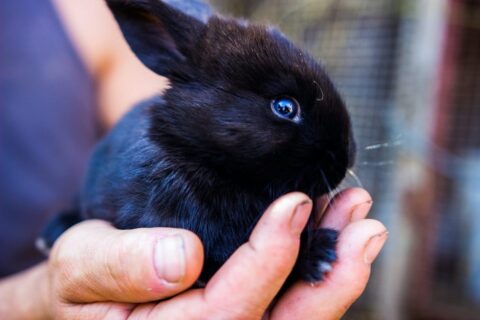News
The House GOP Wants to Cut Food Stamps to Fund Tax Cuts. Will the Senate Get on Board?
Policy•8 min read
Reported
Most families abandon their “Easter rabbits” in less than a year, overburdening shelters with new arrivals following the holiday season. Animal advocates recommend Easter celebrations that are cruelty-free.


Words by Julie Knopp
Every morning at 5:00, Minneapolis-area resident Barb Kelley starts her day cleaning 16 litter boxes, one for every rabbit in her house. When she gets home from work, she does it all again. Kelley cleans nearly 1,000 litter boxes over the course of a month, but she doesn’t mind. “These are my family members. I love them. They amaze me,” Kelley says.
Over the past 15 years, Kelley has dedicated thousands of hours to rabbit education, agility training, and fostering. Her rabbits know 25 verbal commands, including left/right, up/down, hop, and sit. When she’s not training rabbits or cleaning their litter boxes, you might find Kelley toting her registered therapy rabbits to Children’s Hospital, the Melrose Center for Eating Disorders, or nursing homes. Her therapy rabbits offer comfort and joy to people experiencing distress. At Easter, Kelley responds to the celebration of bunnies with increased public education efforts. Kelley’s advocacy reaches countless rabbits and humans each year.
Kelley is the founder of “Hoppy Hour,” a recurring bunny social hour facilitated by the Minnesota Companion Rabbit Society (MCRS). During these social events, more than 100 rabbits, each with a unique appearance and personality, hop around an auditorium filled with boxes, hurdles, and hay. Many rabbits play with the obstacles arranged around the room. Others run up on a wooden bridge. Some cuddle up with a friend or seek affection from humans nearby. Skilled volunteers called “bunny bouncers” monitor the room and handle any accidents or scuffles. Kelley notes that some rabbits at Hoppy Hour clearly seek out friends they’ve met at previous gatherings. “It’s like going to the dog park,” Kelley says.
Not all companion rabbits are given the chance to enjoy the delights of enrichment and exercise. When Kelley started working with rabbits in 2005, the general human population had a very limited understanding of proper rabbit care. Awareness about spaying and neutering rabbits to reduce the population of unwanted bunnies was just beginning to spread. Most rabbits still lived outdoors in small stilted hutches in all weather, and some never experienced the world outside of those wire walls. “No one ever paid any attention to [the caged rabbits], and no one cared. No one thought about it being wrong,” Kelley says. Today, her educational presentations focus on the essentials of proper rabbit care: “diet, spay/neuter, living indoors, no bunnies for Easter.”
The Easter season presents a unique challenge for companion rabbit advocates. Rabbits are a traditional symbol of Easter, and many children delight in the possibility of receiving a pet bunny for the holiday. This decision is rarely made with the best interest of the bunny in mind. Many families quickly tire of a commitment for which they were not prepared. According to Kelley, most families abandon their “Easter rabbits” in less than a year. Shelters and rescue organizations are routinely overburdened following the Easter season.
Rabbit advocates recommend a different kind of Easter celebration. Established by the Columbus House Rabbit Society in 2002, the Make Mine Chocolate! campaign has gained international attention for discouraging live rabbits as Easter gifts. Part of the campaign includes public education about the realities of living with a rabbit. Rabbits are not a low-maintenance or low-cost pet. They require regular veterinary care, often including costly spay or neuter operations, during their 7-10 year lifespans. Companion rabbits need a spacious indoor enclosure with extended time to freely play and explore each day. “The answer for Easter is always chocolate or stuffed. If you want a real bunny, research it. Prepare yourself for it. Know what you’re getting into,” Kelley says.
Easter and other spring traditions celebrate the renewal of life. As warmer weather arrives, Kelley will take her rabbits out in antique buggies. She will bring them to picnics at lakes and restaurant patios. She will continue rescuing rabbits and educating the public about how incredible these creatures are. For the rest of us, a compassionate Easter celebration means one simple, delightful choice: chocolate or stuffed.